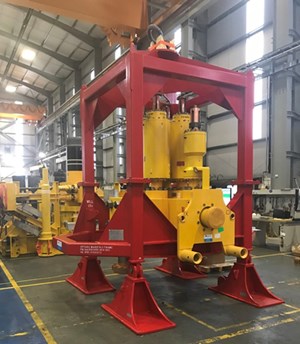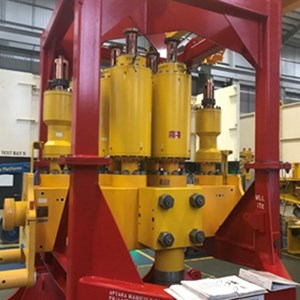Deepwater technology: Manifold destiny: A new blueprint for the energy Trilemma
There has never been a more challenging time for the energy industry, where there is a need to strike the right balance of energy security, sustainability and affordability. In the subsea sector, the search for optimized costs, minimized carbon emissions and maximized performance is set to intensify, as the industry gears to respond to the energy trilemma.
At the same time, the risks to equipment, people and the local terrain and seascape will remain. What the industry needs, in the face of all this, is cost certainty and reduced CO2 emissions, derived not just from technical certainty but also executional certainty.
THE NEED TO ADVANCE
With these concerns front of mind, it is no surprise that research into the performance of subsea equipment and service suppliers, published by Kimberlite LLC in May 2022, showed some concern about the capability of suppliers’ offerings to meet those future requirements.
In particular, 34% of those surveyed said that more advances were needed in subsea trees, citing availability, reliability, cost, lead times and size as areas for improvement. In addition, subsea manifolds were cited separately by another 13% as a technology area that could be advanced.
We agree. As part of our goal to achieve carbon net zero status, we believe that every single aspect of subsea operations is an opportunity to drive improvement. Through our work with clients around the world, we have shown that even equipment like manifolds, which come with some fairly bespoke system design and operation philosophies behind them, can deliver substantial improvements to the areas that matter most to customers, shareholders and regulators.
THE STANDARDISATION CONUNDRUM
The pain points of conventional manifolds are clear and well-understood. Often, as the largest piece of equipment in any given subsea system—acting as an integrator that bridges trees and flowlines and usually designed and built to field-specific requirements—manifolds do not lend themselves to standardized design and fabrication.
That lack of standardization is often the cause of lengthy lead times and a typical delivery schedule of anywhere between 20 and 25 months. As a result, the price of a manifold remains stubbornly high. In addition, the size and weight of traditional designs limit the number of build and test locations that can be used, while installation requires heavy-lift vessels that often have limited availability and high day rates. Once installed, thermal and erosion issues may affect flow assurance and compromise operational output.
All this is reflected in the Kimberlite report. When it comes to manifolds, survey respondents were clear that they wanted better availability, lead times and delivery, as well as technological upgrades and that all-important standardization.
However, the supply and delivery of manifolds is the very definition of a low-volume environment, which makes standardization even harder to achieve. In the past 60 years, somewhere between 7,000 and 8,000 trees have been awarded worldwide. That is an annual average of approximately 140, although this figure has risen to 300 per year in the past decade.
Working on the basis that two thirds of these trees are installed with a manifold, and that there are an average of 4.5 trees per manifold, only 45 manifolds are delivered in the entire subsea industry each year. Due to these low volumes, standardization is a challenge.
OUR MANIFOLD MANIFESTO
This is, nonetheless, a challenge we are determined to solve at Baker Hughes. We recognize that at this point in the business, economic and technology cycle, making superficial changes cannot deliver the results that the industry demands. Our approach to standardization, therefore, is to start at the material level and progress upwards.
Rather than focusing on the design of one of Baker Hughes’ products—the Aptara manifold—in isolation, we instead started with a broad set of system attributes across the entire subsea production system, drawing on our extensive global experience. By considering product improvements as part of a holistic process, we were able to develop optimal levels of structure and standardization for our product. This includes common forgings, valve and actuator parts between the tree and manifold (including common valve block between the tree and manifold), as well as optimizing overall production strategies and maximizing the use of lowest-cost production processes.
The result of this approach is a compact, modular manifold design. It shares certain components and production processes—for example, valves and branch blocks—with the Aptara tree, using standard pressure classes to do so. By using compact branch blocks, the Aptara manifold is lighter, with a much-reduced footprint, which allows for fast and efficient building, transport and installation.
We also identified where standard pipe sizes can be used realistically, to reduce the number of individual parts in the portfolio. This has enabled us to develop configure-to-order manifolds that rely on a limited number of pre-defined components, which reduces highly burdensome lead times.
To define the type of Manifold product to be standardized, data available from the market have been mapped and analyzed, considering the following main parameters:
- Water depth (Shallow or Deep)
- Field layout (Template or Cluster)
- Number of the Headers (Dual and Single)
- Service Header (Gas Lift and Bulk Chemicals System)
- Retrievable number of SCM (with no SCM, single SCM or double SCM)
- Distribution (Integrated or Separated)
A first high-level segmentation, according to these parameters, has been applied, showing that the majority of manifold configurations are within the deepwater range for a cluster manifold with separate distribution. This is the type of Manifold that has been selected for standardization as Aptara Manifold.
As a further step, the following additional parameters have been considered, to define the possible configurations to be developed within the standardization initiative:
- Type of Manifold (Oil or Gas, Producer or Injector)
- Size of the Manifold (6 in or 8 in branch bore)
- Size of the Headers (from 8 in up to 22 in)
- Type of Connections (Horizontal and Vertical)
- Number of XT Slots (2, 4, 6 or 8)
Finally, from the data mapping, different main architectures have been identified as archetypes, and within these archetypes, a manifold base case has been defined according to the data available from the market and previous projects, to start the standardization. A manifold configuration for a 6 in Branch Oil Producer Manifold, with 10 in Header and 6 slots, is the most common configuration represented in the data set. Although, other possible configurations can be obtained with minor modifications and pre-defined interfaces.
The Aptara manifold design includes sub-assemblies that are configurable and modular, so that the base case MTO (Made to Order) configuration can be switched to a CTO (Configure to Order) configuration. This is to be intended as partially defined product assemblies that can be configured with minimal engineering, in line with required delivery commitments. Finally, the CTO configuration can be converted into an ETO (Engineer to Order) Manifold, which is an expansion of the CTO offering, where design features have been considered but no product engineering has been performed.
In practice, this means that 80% of project components can be pre-engineered and digitally configured with speed, operability and reliability in mind. Manufacturing is optimized for repeatability and efficiency, while greater reliance on re-usable parts reduces the maintenance burden. Even relationships with strategic suppliers have been re-structured to optimize costs and lead times.
The key, core item that makes the Aptara manifold an innovative, compact and modular product is our patented 2-slot Master Valve Block assembly. The Master Valve Block (MVB) assembly, as shown in Fig. 1 and Fig. 2, incorporates integrated inboard hubs, with support structure for HCCS-L connections at each well slot (in case of horizontal type connections), one ROV operated isolation valve on the inlet branch from each well, four hydraulically actuated flow switching valves in the center of the main block and two outlet side blocks, one for each header. In case a manifold is required with vertical connections, the hub face can be machined for standard API flange interface and adapted for vertical connections, with the addition of bends and pre-engineered vertical hub modules.
The modular nature of the main valve block assembly means that the manifold layout can be readily configured to cater to different numbers of slots.
The MVB design allows for several advantages; the first one is that it contains, in a compact space, all the valves required to convey the production fluid coming from wells and to split and distribute it to the manifold main headers. The design eliminates branch pipe work, pipe end preparation, fitting, welding and NDE, along with simplified interfaces towards the structure and header pipework. This ensures not only a reduction in costs but also a strong reduction in footprint. The footprint reduction consequentially allows for:
- Reduction in CO2 emissions associated with elimination of welding, part counts
- Reduction in size and working heights
- Reduction in weight
- Reduction in welding
- Reduction in associated costs
- Facilitation of lifting, transport, and installation operations
- Reduction of possible HSE issues and incidents.
The MVB ensures a design that is modular and repeatable; as each MVB conveys the fluid coming from two different wells, this item can be repeated inside the manifold, according to the number of slots required. For example, for a 6-slot case manifold, three MVBs are repeated. The modularity of the design ensures:
- Modularization of manufacturing, testing and assembling sequences
- Reduction of lead time
- Automation
- The future possibility to include all-electric components, without affecting the design
With the above outlined design decisions and a change of manufacturing strategies, there is a significant improvement in the Aptara manifold’s carbon footprint during all the life cycle stages when compared to a conventional manifold.
Additional benefits are foreseen in the areas of:
- Installation:
-
- Use of lower-class vessels, due to lower product weight, can result in significant CO2 savings.
- Faster installation time, with an integrated mudmat and with faster tie-ins, will reduce the offshore duration of vessels, which reduces both cost and CO2 emissions.
- Operations:
-
- There are benefits with compact design in terms of thermal management and erosion management, which can provide enhanced operational benefits in terms of required chemical injections and intervention needs, which in turn will result in lower carbon emissions.
-
- Decommissioning and End of life:
- Ease of recovery and recycling can benefit in a circular economy.
RESULTS IN THE FIELD
As a result, Aptara manifolds have already made a measurable difference in terms of sustainability and efficiency to our clients’ operations. CO2 emissions have been reduced by 40%, weld requirements 85%, typical manifold size 55% and weight 40%. Not to mention, flow assurance has improved, with thermal and erosion capability providing greater flexibility in different operating scenarios and shutdowns.
From design and fabrication, through logistics and delivery, to installation and eventual shutdown, every aspect of the Aptara manifold has been challenged, considered, assessed and re-worked as necessary. Like all elements within our Subsea Connect system, it has been assessed through a “life of field” lens, which takes CO2 reduction into account, to establish where improvements are possible—and justifiable.
It is proven that such an approach can deliver substantial results. In fact, it has been proved that such an approach is necessary to create a sustainable, viable and socially acceptable future for our sector.
About the Author
Caterina Galli graduated from the University of Florence with a master’s degree in mechanical engineering in 2012. In that same year, she joined General Electric, Oil and Gas, starting her experience with an internship in a turbomachinery engineering group, studying the thermo-fluid dynamics of lubricating systems for gas turbines, for very low temperature applications. Then, she joined the subsea oilfield equipment business as an Xmas tree engineer, working on Xmas tree product design and technical documentation for different projects and customers. In 2019, during the transition from General Electric to Baker Hughes, Ms. Galli started the role of Project Package lead engineer, working on the installation, testing and shipping of tools for Xmas trees. From the end of 2020, she has worked as Project Engineering manager for new manifold product development at Baker Hughes.





